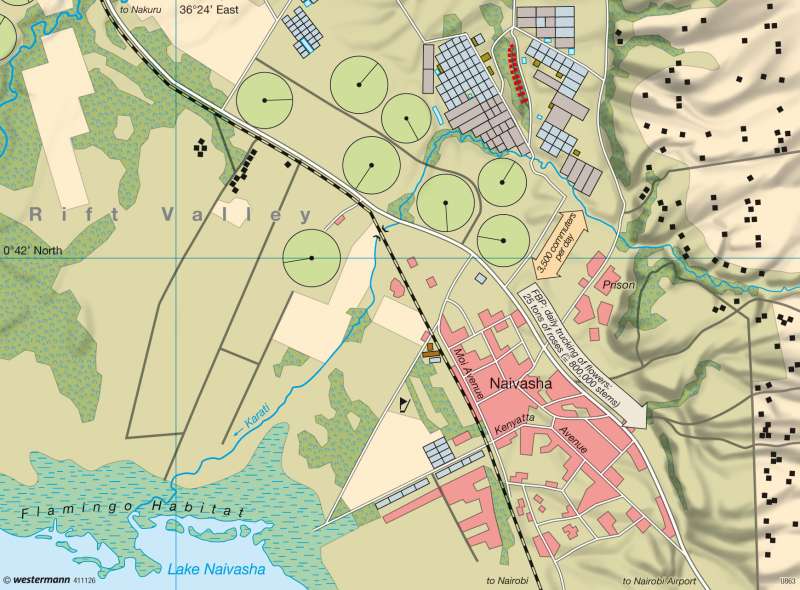Naivasha (Kenya) — Rose cultivation for the EU market
Africa - Agriculture
978-3-14-100790-9 | Page 159 | Ill. 3

Information
Especially in winter, many cut flowers sold in northern Europe originate from countries in the southern hemisphere. For example, the climate in the Equatorial tablelands is ideal for the rose, which is by far the best-selling flower in Germany. In those regions the light and temperature conditions necessary for rose growing, which in Europe would need to be created artificially, are present constantly throughout the year. Therefore, despite high transport and airfreight costs, it is still economically profitable to import roses from countries around the Equator. For countries like Kenya, Tanzania or Ecuador, cut flowers have now become one of their most important export products. Their ability to compete with regional producers despite the long transport distances is based not only on their low energy costs but also on low wage costs in these countries.A worker in Kenya, who works full-time in a flower plantation, earns as a rule between 30 and 40 euros per month. This is not sufficient to feed the family. Furthermore there are many hours of overtime, especially for events such as Valentine's Day or Mother's day. Many workers have no fixed contracts and therefore cannot rely on a secure livelihood. Their work exposes them to the chemicals that are apparently essential for the cultivation of roses in monoculture. Appropriate protective measures are urgently necessary but only rarely implemented.
Flower Label and TransFair
For this reason, human rights organizations, trade unions, flower dealers and flower producers founded the "Flower Label Programme" in the mid-1990s. The aim of the programme is to improve environmental and social standards in worldwide flower production. In order to achieve this, the association uses the instrument of certification among other things. Flower farms that are proved to fulfil the criteria of the FLP standard are permitted to display the Flower Label on their goods. In general terms the criteria include: no child or forced labour, a living wage, freedom to organize in trade unions, health protection, the avoidance of highly toxic pesticides, and a responsible approach to natural resources. Shoppers who request flowers with the quality label are showing their support for a form of cultivation that respects human rights and protects the environment.
The fair trade organization TransFair e. V. has also been offering roses with a quality label since 2005 under the name "Fairfleurs". The TransFair label stands not only for fair production but also for fair trade. This means that the roses are sold with a surcharge, part of which flows back to the producers and their workforce. There, the money is used for social projects. Thus the customer pays a little more but is making a contribution to development cooperation. Roses with the Fairfleurs label can only be sold in pre-packed bunches of ten to Transfair licensees. These are, in the main, supermarkets and discount florists. The table "Rose Price Structure" gives an overview of the cost structure of Fairfleurs roses in comparison to conventional supermarket products.
Naturally the price structure in specialist retail florists is completely different, because higher qualities are processed and the final price also reflects the florist's skills. Flowers with the FLP label do not carry any artificial surcharge. However the strategy consists of recognizing fair production as an additional quality criterion to be included in the price negotiations. Thus, just as with fair trade products, demand is the essential component of the programme.
S. Peters; Ü: J. Attfield




